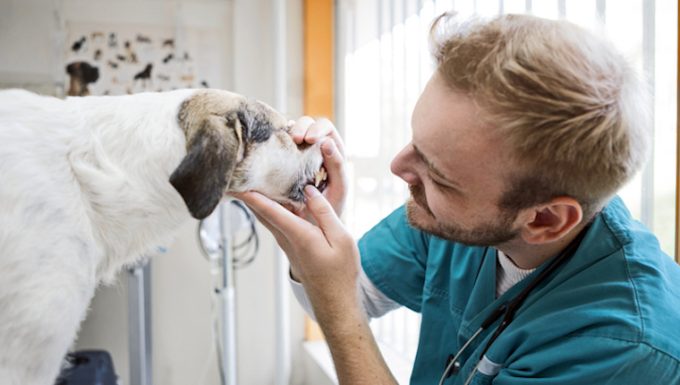Oral chondrosarcoma in dogs is a type of bone cancer that starts in the mouth. Specifically, the condition is caused by tumors in cartilage.
The condition is considered to be rare. But unfortunately large breeds of dog seem to develop it more than smaller dogs. Also, middle-aged and older dogs suffer from the condition more than younger pups.
Technically, chondrosarcoma can also affect other parts of a dog’s body, such as the ribs or pelvis. You can read more about that condition in general here.
If you see the signs of oral chondrosarcoma in your dog, then get to a veterinarian for a proper diagnosis and treatment.
Here’s what you should know about the symptoms, causes, and treatments for the condition.
Symptoms of Oral Chondrosarcoma in Dogs
The condition produces a range of symptoms. For example, some of the most common symptoms include:
- Bad breath
- Weight loss
- Swollen lymph nodes
- Drooling
- Problems eating
- Bleeding at the mouth
- Lethargy
- Coughing
- Sneezing
Causes of Oral Chondrosarcoma in Dogs

The cause of the condition is unknown. This is called being idiopathic. However, larger breeds suffer from the condition more than smaller breeds. Also, middle-aged and older dogs develop the condition more than younger dogs.
Additionally, male dogs seem more likely to develop the condition than female dogs.
Treatments for Oral Chondrosarcoma in Dogs
Firstly, your vet will ask about your dog’s symptoms. Secondly, your vet will ask about your dog’s full medical history. This will include breed-specific problems.
Thirdly, your vet will carry out a full physical examination. Additionally, X-rays can be used to highlight any problems. Ultimately, your vet will need to take a deep tissue sample from your dog to analyze and confirm the condition.
Generally, treatment focusses on removing the tumor. This is a surgical procedure. In some cases, parts of your dog’s jaw may need to be removed.
Additionally, your dog will need oral pain medication while they recover. This will be prescribed by your vet. As always, if your vet prescribes your dog any medicine, make sure to stick to the correct dose and frequency instructions. Also, complete the full course of medicine.
While recovering at home it is important to provide your dog with a quiet and calm environment. Also, your dog’s exercise might need to be limited at first.
Have you ever cared for a dog who suffered from this condition? How did your vet help your dog recover? Let us know in the comments section below.









